Livingstonia: a glimpse of Malawi’s colonial past
Perched high on an escarpment overlooking Lake Malawi, Livingstonia was established by missionaries from the Free Church of Scotland back in 1894. The story goes that they tried several times to establish missions down on the shore of the lake, but kept losing missionaries to malaria until they moved up the escarpment to higher, less mosquito-ridden, ground.
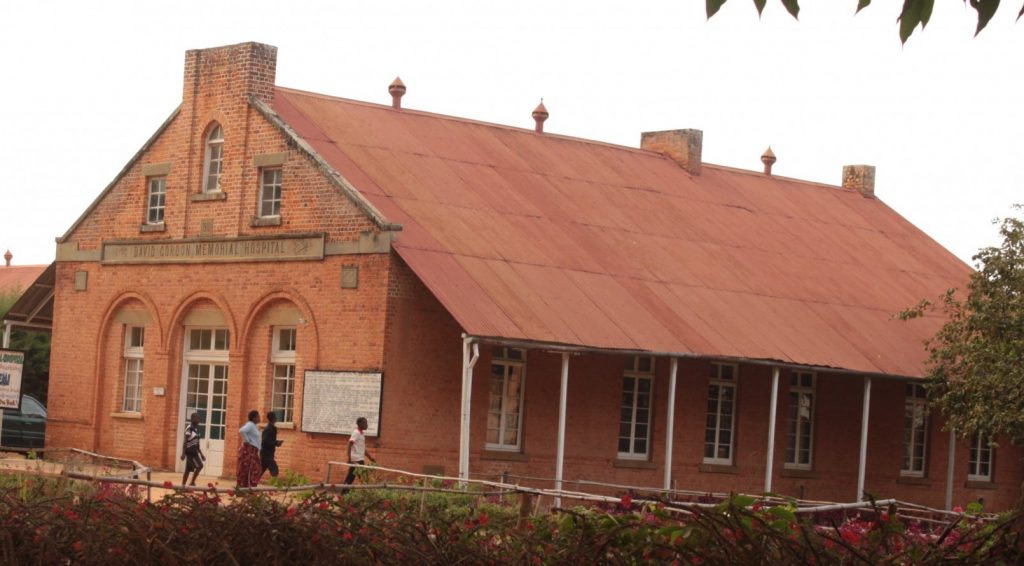
Livingstonia is named after David Livingstone, the Scottish missionary of “Dr. Livingstone, I presume?” fame. He died twenty years before the mission was founded, but he paved the way for European settlement in Malawi through his missionary expeditions to spread “Christianity, Commerce and Civilization” and to fight against the slave trade. He was seen as a hero by later missionaries.
What to see in Livingstonia
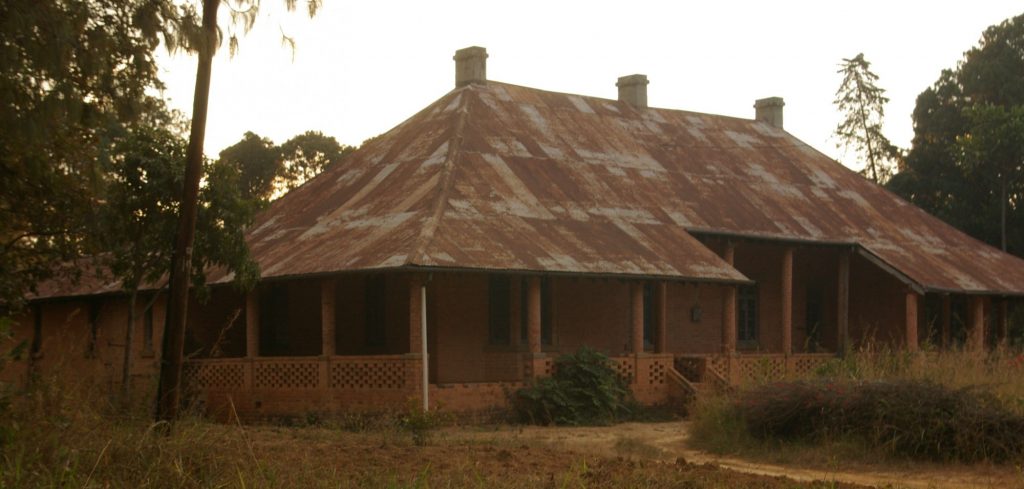
The original church, a hospital, a school (now a university) and a number of other colonial-era buildings still stand and are in use. Strolling around the red-brick buildings, cool under the trees, you can clearly imagine what it was like back then. I could practically see those pale Scottish men, dressed in khakis—wearing knee socks in my imagination—sitting on the verandas of these houses, being served gin and tonics by their local servants.
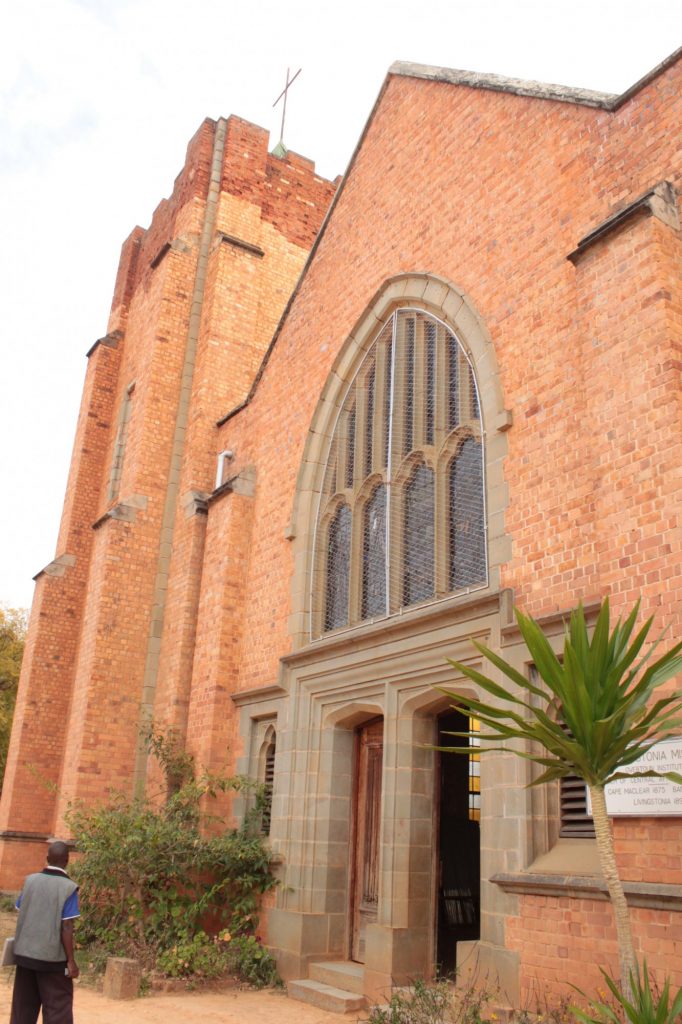
Make sure to go into the Livingstonia church. Notice the stained glass over the entrance depicting Livingstone, presumably preaching his missionary message. It’s … well, I’ll let you judge for yourself:
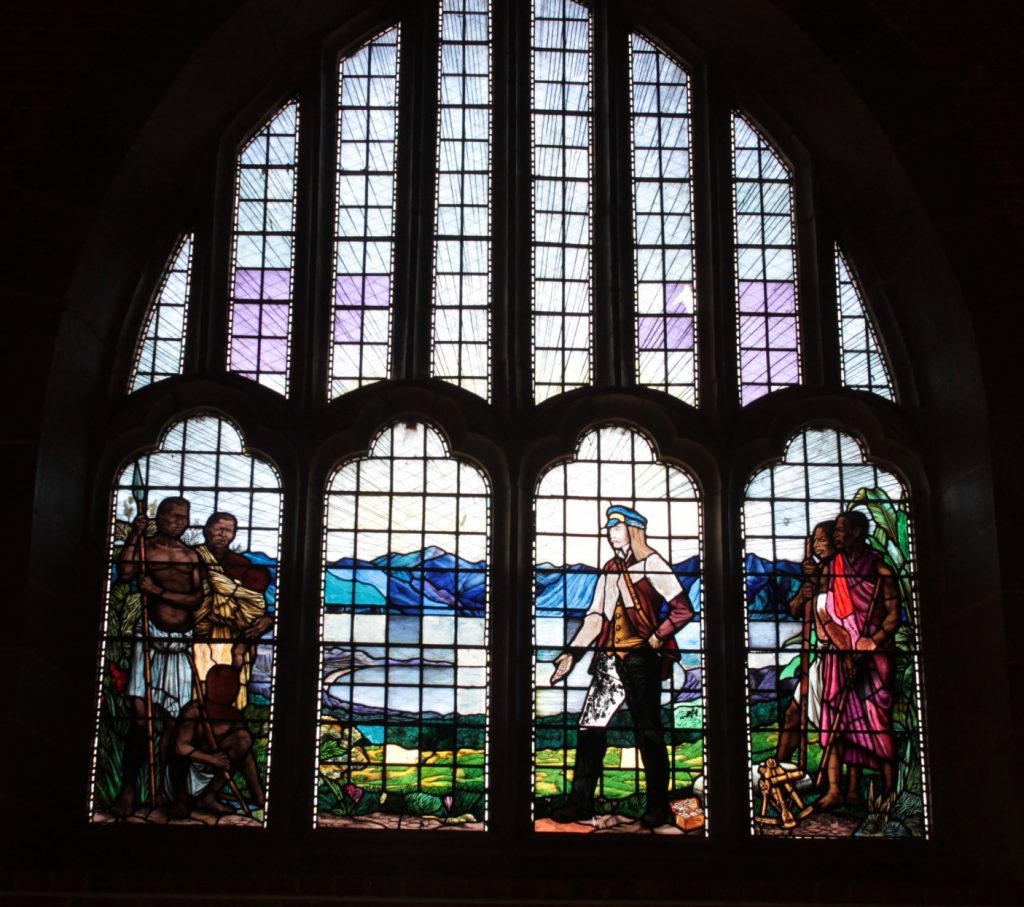
If you’re there on a Sunday, it’s worth attending services, even if you’re not a believer; I promise you will love the Malawian traditional singing. The video below shows a church choir rehearsing in a different town, but you can hear what I mean about the Malawian style. Imagine this with the acoustics of a big church:
The Stonehouse, a small museum, is worth a quick visit to learn about the history of Livingstonia. It’s housed in the only one of the original buildings made from stone rather than brick. It also offers modest guesthouse beds and campsites.
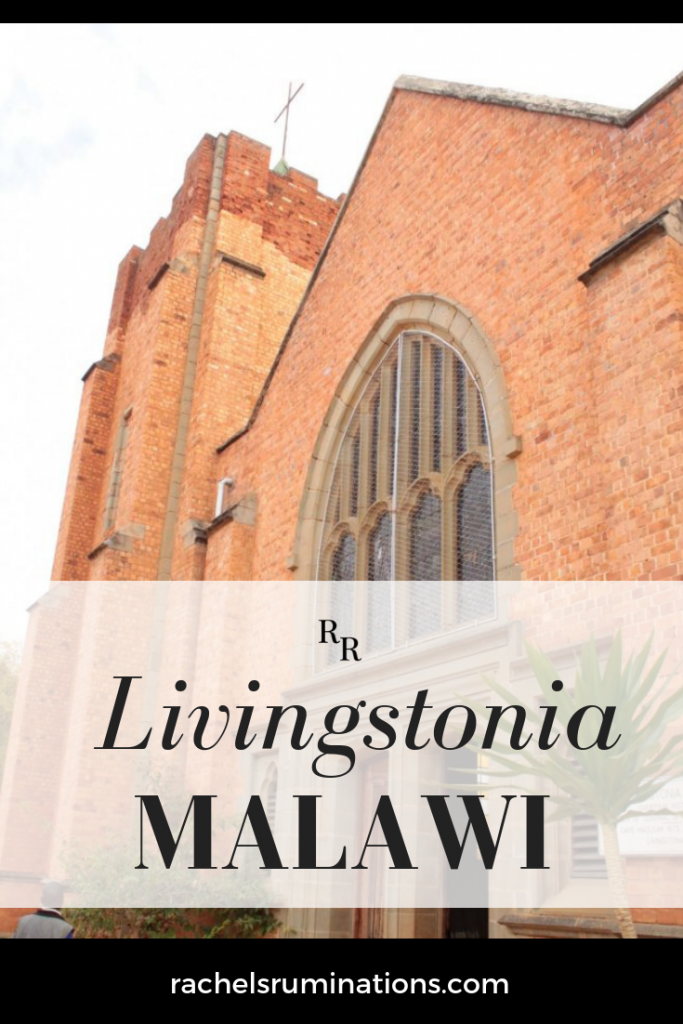
Getting to Livingstonia
Getting to Livingstonia is a challenge since none of the roads are good. You can approach from the south, but I’d recommend driving up from Chitimba, but only do this if you have a sturdy four-wheel drive vehicle. This route to Livingstonia is nicknamed “the 21 bends,” meaning hairpin turns, but, believe me, you won’t be going fast!
This is more Paris-Dakar race (only slower!) than Monaco Grand Prix. Driving it is, at times, like driving up a steep, dry mountain stream bed: all sharp jutting rocks. It’s paved here and there, though never for long. Let’s just say it is not for the faint of heart. Nevertheless, the views of the lake open up as you ascend: truly breathtaking! This video I found on YouTube shows the road, though not the rockiest parts, which are on the hairpins themselves:
Where to stay
A number of accommodations are available in and around Livingstonia to cater to tourists. I can’t judge any except the one we stayed in, Lukwe Ecocamp, but they do not appear to have survived the pandemic. However, Mushroom Farm Ecolodge is just down the road. I don’t know what it’s like, but the views will be similar. This location on the edge of the escarpment offers breathtaking views over the lake far below.
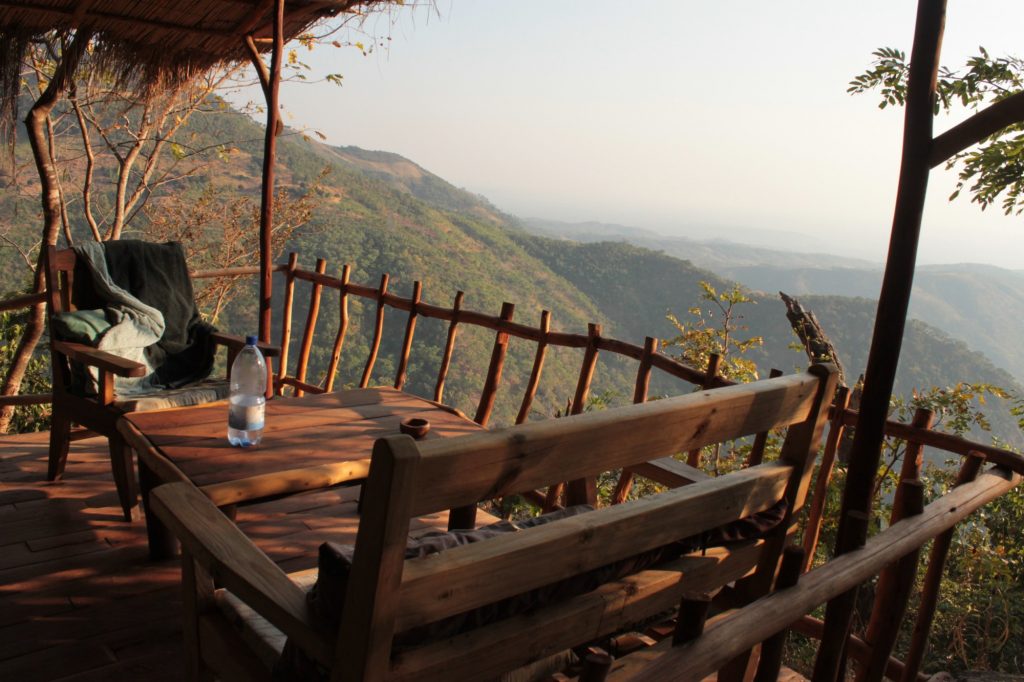
Visiting Livingstonia combines well with a visit to Nyika National Park and, of course, with a bit of relaxation or watersport on Lake Malawi.
Have you ever been to Malawi? What would you recommend seeing?

My travel recommendations
Planning travel
- Skyscanner is where I always start my flight searches.
- Booking.com is the company I use most for finding accommodations. If you prefer, Expedia offers more or less the same.
- Discover Cars offers an easy way to compare prices from all of the major car-rental companies in one place.
- Use Viator or GetYourGuide to find walking tours, day tours, airport pickups, city cards, tickets and whatever else you need at your destination.
- Bookmundi is great when you’re looking for a longer tour of a few days to a few weeks, private or with a group, pretty much anywhere in the world. Lots of different tour companies list their tours here, so you can comparison shop.
- GetTransfer is the place to book your airport-to-hotel transfers (and vice-versa). It’s so reassuring to have this all set up and paid for ahead of time, rather than having to make decisions after a long, tiring flight!
- Buy a GoCity Pass when you’re planning to do a lot of sightseeing on a city trip. It can save you a lot on admissions to museums and other attractions in big cities like New York and Amsterdam.
Other travel-related items
- It’s really awkward to have to rely on WIFI when you travel overseas. I’ve tried several e-sim cards, and GigSky’s e-sim was the one that was easiest to activate and use. You buy it through their app and activate it when you need it. Use the code RACHEL10 to get a 10% discount!
- Another option I just recently tried for the first time is a portable wifi modem by WifiCandy. It supports up to 8 devices and you just carry it along in your pocket or bag! If you’re traveling with a family or group, it might end up cheaper to use than an e-sim. Use the code RACHELSRUMINATIONS for a 10% discount.
- I’m a fan of SCOTTeVEST’s jackets and vests because when I wear one, I don’t have to carry a handbag. I feel like all my stuff is safer when I travel because it’s in inside pockets close to my body.
- I use ExpressVPN on my phone and laptop when I travel. It keeps me safe from hackers when I use public or hotel wifi.



What crazy road (and you say the video doesn’t show the worst parts!). If it is difficult to make it to the town nowadays, I can’t imagine the troubles the missionaries had to get there. Reminds me of one of the roads we recently took in Mexico. We even had to cross a river.
I suppose the missionaries walked (and some people hike up nowadays too). They would have had servants to carry their things up though. Yes, crossing streams is sometimes necessary in Malawi too, generally in the rainy season. Another reason to drive a high-clearance 4-wheel drive vehicle.
OK You won me with those Chalets. That magical view would inspire many a day dream on my part. I followed your link to Nyika. Scotland with Zebras sounds perfect. How come you lived in Malawi for two years?
I was in the Peace Corps, teaching in a secondary school in Mzuzu.
Now that would have been an experience.
It was!
That is a beautiful journey described.
I haven’t been anywhere near to Malawi yet! The road doesn’t look motor-able yet it seems adventurous.
It wasn’t exactly great for my back. The jarring takes its toll!
Paved roads are so overrated, don’t you think? LOL!
Seriously, though, the hospital seems to be in quite a remote location. I guess the bikes also act as ambulances for the sick. Life for too many of us is such a challenge.
Love the view from your chalet!
Although Livingstonia seems remote because the roads are bad, it’s a big community. Lots of people live nearby, either in Livingstonia or in surrounding villages.
Wee haven’t been to Malawi yet, but it looks fascinating. The view from the chalet is incredible!
Unfortunately I don’t seem to have a picture of the rest of the view, but take my word for it, it was also incredible, and reached all the way down to the lake.
So of course I had no idea that Dr. Livingstone was a missionary. Gettingto to Livingstonia is a challenge. THOSE roads will kill me (make me nauseated!) but the view from the chalet would be worth it. Lovely!
Yes, and apparently he was also very strongly anti-slavery. I’m not sure that the roads would bother you like hairpin roads in, say, the alps would. You drive really slowly. It’s hard on the spine, though!
Hi Rachel! I had never heard of Livingstonia until today. However, as soon as I read the name I thought it had to be connected to the Mr. Livingstone. Getting there sounds like an adventure. Being a solo traveler, I’m not sure I’d want to venture those hairpin curves alone. Maybe I can advertice for a travel buddy 🙂 I’d love to the hear the singing in the church, and those views would mean a lot to time spent lingering. Thanks for hosting this week. Sorry I am not around that much. Writing assignments are starting to flow in, so I’m going through a lot of ink right now! Thanks for hosting this week. #TPThursday
Malawi is a very safe country to travel in, if you are prepared. But it would be nicer with a travel buddy!
Thanks for introducing me to the country of Malawi and Livingstonia. It sounds way off the beaten path even with that incredible chalet and view- just the kind of place I like! And thanks also for sharing the Malawi Gospel Music video – I loved the “feel” of the melody and rhythm.
Yes, I’m completely ignorant about music, but I love the way their voices blend!
Interesting post…made me wonder what led you to Livingstonia. You certainly didn’t trip on it:-)
I was living in Mzuzu, Malawi, in the Peace Corps, the first times I went there. This recent visit was a trip down memory lane with my husband (who I met in Malawi) and our children, 25 years or so after I left Malawi. Livingstonia was one of our favorite places, so we had to show it to the kids!
I unfortunately want to make a correction. Livingstonia is named for David Livingstone not Stanley. It was Morton Stanley who located him in Africa.
Oh, of course! I knew that, yet still got it wrong! Thank you! I’ll change it in the article.
Aha, I see you’ve been here too. The escarpment up to Livingstonia is definitely on our list and I’m looking forward to the 21 bends – appropriately we’re on Honda Africa Twins so we should cope with the terrain. I think we’ll go through Vwaza Marsh as well having read your blog – assuming we’re able to on bikes.
On off-road bikes neither will be much trouble, though you won’t be able to move very fast – those bends are sharp, and the road is in really bad shape – or it was when I was there. Please do let me know if they’ve finally paved it properly!